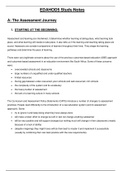Study guide
EDAHOD5 The Educator as Assessor Study Notes
- Institution
- University Of South Africa (Unisa)
This document contains a detailed summary of the Study Guide and the assigned book for The Assessor as Educator. It is perfect for exam preparation.
[Show more]




